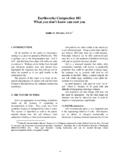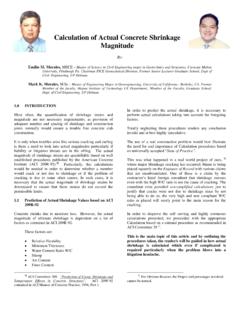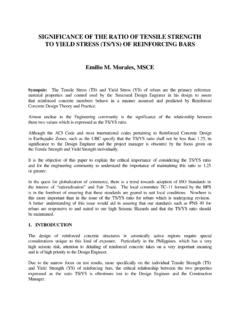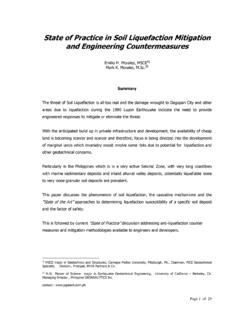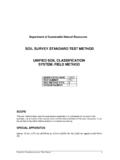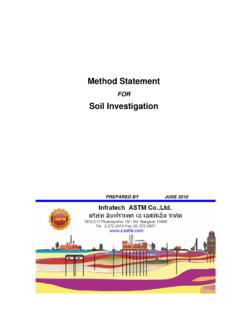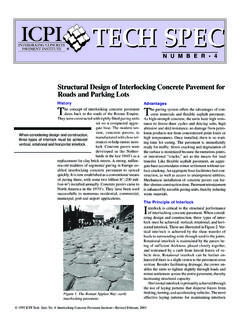Transcription of THE CHERRY HILLS LANDSLIDE TRAGEDY - PGATECH
1 The 2nd Civil Engineering Conference in the Asian Region, Tokyo, 2001 - 1 - THE CHERRY HILLS LANDSLIDE TRAGEDY Emilio MORALES; Marissa CAMACLANG; Gilberto REYES Chairman, PICE Geotechnical Committee; Member, PICE Geotechnical Committee; Member, PICE Geotechnical Committee; The tragic loss of 58 lives in the CHERRY HILLS LANDSLIDE attracted a lot of Philippine & International media attention and with it a lot of speculations and rumors as to what caused the slide. Several professional organizations and government agencies were also involved in the various studies and investigations to understand what really happened. This report summarizes and documents the work of the committee, including the methodologies and tools employed in reconstructing the conditions before and after the LANDSLIDE , its findings and conclusions.
2 This paper summarizes the collective independent findings and conclusions of the authors. 1. INTRODUCTION Right after the CHERRY HILLS LANDSLIDE , which occurred on the night of 3 August 1999, the Philippine Institute of Civil Engineers (PICE) and Association of Structural Engineer of the Philippines (ASEP) mobilized members of its Geotechnical Committees in order to volunteer its services in the documentation of the CHERRY HILLS LANDSLIDE . The intention was to focus its attention on the Engineering aspects of the overall investigation. It was necessary to understand what caused the LANDSLIDE , how the landslides occurred and how such mechanism/s can be prevented or avoided in the future.
3 It is the intention to disseminate this report to all interested parties and to the Engineering Profession in particular so that lessons learned can be applied to prevent future similar accidents. 2. BACKGROUND OF CHERRY HILLS LANDSLIDE (1) Location of CHERRY HILLS Subdivision The subdivision is located in Antipolo City, Province of Rizal, Luzon Island, the Philippines. It is situated in saddle like fashion in an elevated terrain cut from a mountain leaving the East and West Flanks. It is flanked by two subdivisions, Park Village Subdivision to the North and Peace Village to the South.
4 The East and West flanks are bounded by the mountain sides left after the cut. The Eastern Summit is at elevation 255m Map and the Western side is at elevation 233m. The subdivision cut from the mountain side is approximately 26m at its deepest. (2) Extent of Development of CHERRY HILLS The subdivision encompasses an area of approximately 5 Hectares. All the roads have been paved with plain Portland cement concrete. The subdivision residential units consist of two and single storey houses that are either single detached or row housing. These are light roofed houses with hollow block wall construction and reinforced concrete columns on isolated footings.
5 (3) The LANDSLIDE The LANDSLIDE occurred at approximately 7:00 PM of August 3, 1999. Several hours before the event a lot of residents have evacuated their homes because of telltale signs of the impending slide. Cracks were being observed in some houses which continued progressively, thus, providing ominous signs that were heeded by some. When the LANDSLIDE occurred, it was very sudden and according to some eyewitnesses, occurred within five seconds. Two loud noises were heard during the The 2nd Civil Engineering Conference in the Asian Region, Tokyo, 2001 - 2 - LANDSLIDE . Fifty Eight (58) lives were lost and one unaccounted for in this slide event.
6 Interviews with some homeowners indicated that there have been manifestations of movements in the Subdivision platform (creep) as manifested by crackings on the walls and difficulties encountered in the closing and opening of doors and windows. this happened several months before the LANDSLIDE . 3. DATA GATHERING FOR THE ENGINEERING STUDIES With the data already collected on the Geology of the area and specifically the orientations of bedding planes and joints in the rock mass, the Geotechnical Investigation Team concentrated on the following objectives: (1) Data Gathering a) Reconstruction of the Digital Terrain Model (DTM) of the area from the National Mapping and Resource Information Agency (NAMRIA).
7 Maps were done as the reference point for the subsequent subdivision development, to establish platform elevations. b) Mapping of the slide zone and CHERRY HILLS Subdivision in relation to the existing Digital Terrain Model by Global Positioning System (GPS) Surveys. c) Gathering of subsurface data by conducting soil exploration in the slide zone and the undisturbed areas. d) Gathering of intact block samples for strength testing of cores obtained and classification of soil samples using the Unified Soil Classification System (USCS). e) Extraction of rock cores from intact blocks and simulation of the effects of groundwater conditions on intact cores through saturation (obtained from within the same sample block).
8 (2) Analysis of Strength Data Numerous Unconfined Compression Tests (UCT) were conducted on intact cores obtained from borings and from corings done on block samples gathered from the slide areas. The cores consisted of the various layers of sandstone and the thin siltstone seams interbedded with the sandstones. The results of the Unconfined Compression Strength Test show the range of values of Uniaxial Compressive Strength (qu) of the rock layers in the area. The Scatter Chart in Figure below shows the values for both rock types obtained from the borings. Depth (m)qu ( ) Values051015202530350510152025 Highly Fractured Layersdown to generally qu vs.
9 Depth for intact rock cores from Borings. Although these represent the material strengths of the intact rocks from a generic sense, it does not give an idea as to the actual Characteristic Rock Mass Strength (CRMS) during the slide. The Characteristic Rock Mass Strength is the "average" strength of the rocks along the failure plane at failure. For determining the latter, it would be necessary to consider the degree of jointing, weathering and the other environmental factors that could affect the characteristic strength. The Uniaxial Compressive Strengths from intact cores served only as the reference base or starting point from which approximations of the CRMS at impending slide could be obtained.
10 This will be discussed subsequently. (3) Effect of Water Saturation on Strength of Cores The cores from within the same block samples were grouped and subjected to immersion for 24 hours, 48 hours and 72 hours. The plot of the Unconfined Compressive Strength qu (kg/cm2) vs. Moisture Content (%) is presented in Figure for Sandstone and Siltstone Cores. The 2nd Civil Engineering Conference in the Asian Region, Tokyo, 2001 - 3 - qu vs MC for Siltstone020406080100120140020406080 Moisture Content in %Unconfined CompressiveStrength kg/cm2 Unconfined Compressive Strength for Intact Sandstone and Siltstone Cores.
